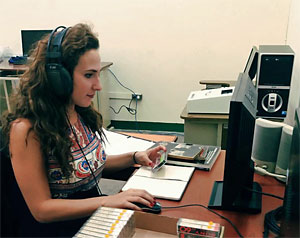Preserving Revolutionary History
June 16th, 2017 | SIT Study Abroad
Alumna Rebecca Cooley won a Fulbright fellowship to continue work she began with SIT Nicaragua

Rebecca Cooley
BA in international relations and political science, Tufts University, 2016
Alumna, SIT Nicaragua: Youth Culture, Literacy, and Media, 2015
While studying with SIT, Rebecca Cooley learned about an archive of almost 7,000 cassette tapes of interviews recorded all over Nicaragua just after the country’s Sandinista Revolution in 1979. Through summer 2017, she’s living in Managua, Nicaragua, working as a Fulbright fellow to help digitize and restore this important audio archive.
Why did you decide to study in Nicaragua? What was the most valuable part of your experience?
As an international relations major concentrating regionally in Latin America, I always knew I wanted to study abroad. When junior year came around, I wasn’t feeling very inspired about my plan to study in Chile in the spring. I wasn’t feeling the excitement and anticipation I felt coming into university. A few professors and fellow students highly recommended the SIT programs. I liked the focus on experiential learning, the extensive travel itineraries, and the opportunity to conduct my own research with the Independent Study Project [ISP].
I would say the most valuable part of my experience in Nicaragua was the connections the program facilitated. My entire current academic and social life in Nicaragua grew out of connections I made during the program. I am still close with the families in the Maximo Jerez who hosted us. Today I am good friends with the conversation partners we talked with during our lunch breaks, and it was during the program that I first visited and worked with the Institute of Nicaraguan and Central American history, where I now work on my Fulbright project. These connections were directly and purposely established by the SIT program with the intent to create sustaining relationships on an interpersonal and institutional level.
How did you first learn about the cassettes at the Institute of History of Nicaragua and Central America, or IHNCA?
My mentor and advisor at my university was actually hoping I would study abroad in Chile, where he was an expert in the history. When I decided to study abroad in Nicaragua, he told me what he knew of from his field of memory studies. He said, “There is an oral history archive from the revolution no one has listened to. You should look for it.”
Without a name or specific location, I assumed there was no way I would ever find the archive – until I walked right into the archive while on an SIT tour of the Institute of Nicaraguan and Central American History! An entire room filled from floor to ceiling with cassette tapes – 6,927, to be exact.
What led you to return to Nicaragua as a Fulbright scholar?
It was through SIT that I learned about the IHNCA, where I was captivated by their focus on memory studies. SIT paired me with one of the researchers at the IHNCA to serve as my advisor for my ISP. My ISP grew into my senior honors thesis – “A Swinging Pendulum of History: Politics, Pedagogy, and Unconsolidated Memory in Nicaragua.”
One of the major conclusions from this research was that young Nicaraguans learning about the Sandinista Revolution felt they could not trust traditional secondary sources such as monuments or text books. These sources were tampered with by constantly shifting political ideologies. Instead, these young people relied on the subjective but authentic firsthand accounts from parents and neighbors. This reminded me of the oral history archive, a compilation of thousands of subjective but authentic primary sources.
Through my ISP advisor and my program director, I learned that this oral history archive was just sitting there in the basement. The institute had been preserving the cassettes for many decades, but without funding and personnel, they were unable to make the unique collection accessible. I approached the scholar development representative at Tufts and she suggested the Fulbright grant as an opportunity to receive the necessary funding to realize this project. The Fulbright Committee seemed to agree on the importance of this project and approved my application.
What does the future of this project look like to you?
This project will go well beyond my 10 months here. The objectives – to digitize, restore, and make accessible – will likely take another 18 months to complete. Right now, I am focused on digitizing the tapes and establishing an editing process to improve the sound quality of the tapes. I am also helping lay out the following steps, which will include transcribing all of the cassettes, writing content summaries with keywords, and uploading the cassettes and transcripts to a multimedia database.
Then there will be a process of selection of which cassettes can safely be made publicly accessible. Not only is it necessary to curate a selection of the almost 7,000 cassettes, but these cassettes include the delicate political views of people who are alive, along with all their personal information such as full name and address. Making this archive accessible will be a sensitive and thoughtful process. But I hope this will all lead to an explosion of academic and artistic projects. I see hundreds of potential investigations that could utilize this archive, from historical to psychological to anthropological and sociological. This huge sampling of individuals in such a unique time period offers a remarkable opportunity for academia. Additionally I hope to encourage artistic collaborations such as musicians sampling the audio, or theater pieces inspired by these real testimonies. The possibilities are infinite.
